Catholic Customs
 |
 |
 |
 |
 |
 |
 |
Trees of Paradise & Fruitful Grain
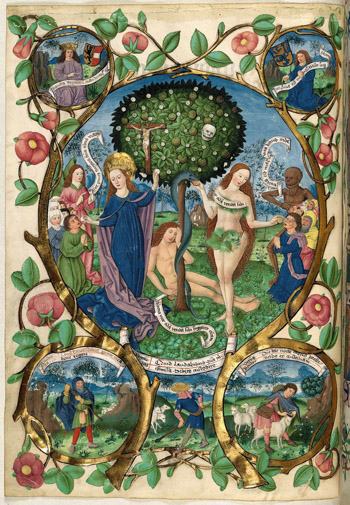
A medieval depiction of the Tree of Life
in the Garden of Eden
When Our Lord was raised on the Cross, the mysteries of that Tree of Paradise were revealed, as the Church proclaimed the Cross to be the true Tree of Life in the hymn Crux Fidelis: “O faithful cross! Thou noblest of all trees. No forest yields thy like, in leaf, or flower, or fruit.
Indeed, this world is filled with forests and groves, yet amidst the myriad trees, man will never again find the Tree of Life except in the Cross. The last weeks of Advent are a fitting time to contemplate these mysteries, bringing us back to our first parents.
Origins of the Christmas tree: the Paradise Play
The story of the Creation of the world and the fall of Adam and Eve were brought to life for our Catholic forefathers during Advent and Christmas with the Paradise Play that was performed in churches and streets, especially in Germany during the 11th century.
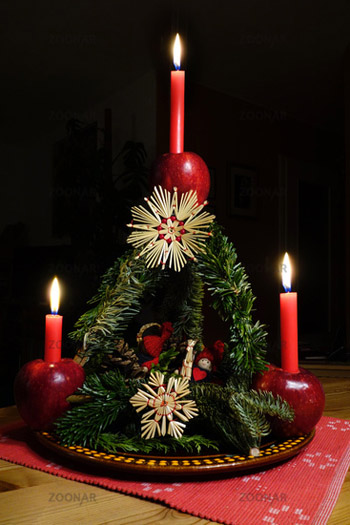
A Bavarian Paradeisl
It ended with a message of hope in the Savior who would come to earth and give His Body and Blood for the forgiveness of sins. To symbolize this hope, wafers – symbolic of the Holy Eucharist – were hung on the tree. It was these plays that inspired Catholics to bring evergreen trees or branches into their homes at Christmas and adorn them with apples and wafers.
By the 12th century in Central Europe, many homes were hanging such trees upside down from their ceilings, and by the late Middle Ages, paper roses, gold leaf and sweets were added to the tree’s adornment, the sweets being symbolic of the sweetness of Redemption.
Christmas Eve, which is unofficially the feast of Adam and Eve in the West and the official feast day in the East, became the traditional day for erecting these trees, a proper choice for trees so reminiscent of Paradise. Many Germans even called them “Paradise trees.” In Bavaria, Paradeisl made of branches or little fir trees shaped as a pyramid with a candle inserted into an apple at each corner are still assembled. (2)
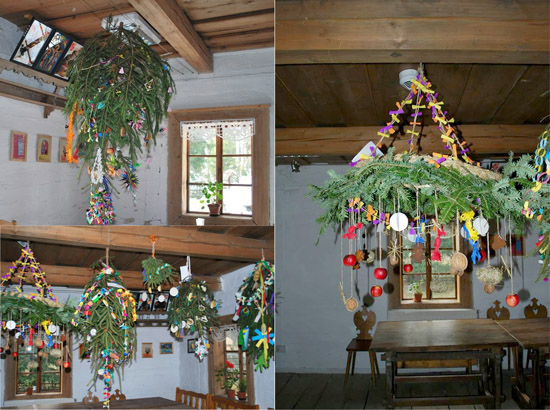
Polish połaźnik hang from the ceilings of homes in festive array
The brilliant tree is set upright
The upright Christmas tree as we know it today originated in the 15th century in Germany. From Germany, the Christmas tree spread to England, the Northern countries and other European countries, especially during the 19th century. Lights were not added to the Christmas tree until the middle of the 17th century when the trees gradually began to replace the German Christmas pyramids in representing Christ as the Light of the World. (5)
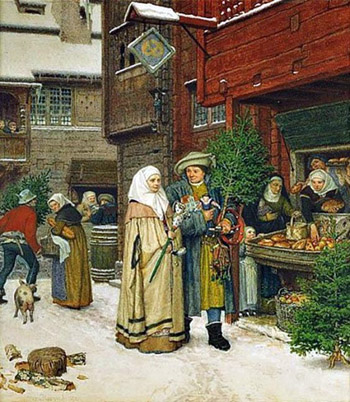
A German couple returns home with their fir tree; below, a Royal Family admiring their marvelous tree
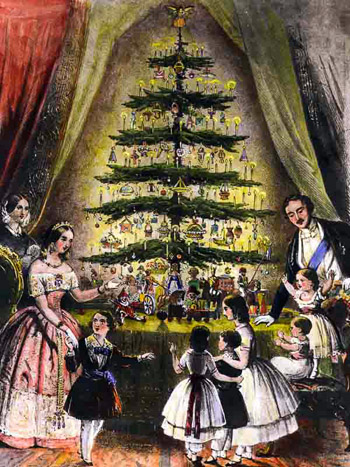
The whole family entered the room to admire the fairy-like tree, said to be a gift from the Christ Child Himself, shining with lighted tapers, toys, cookies, balls, paper flowers and other ornaments. Children were especially delighted to find the strands of angel hair (tinsel) left on the tree from the Angels who assisted the Christ Child.
Beautiful Nativity scenes protruded from the base of the tree. One family member read the Nativity story and everyone joined in singing carols. Surrounding the tree sat tables covered in white linen and laden with the gifts brought by the Christ Child as well as handmade gifts lovingly made by family members. (6)
As the custom of the Christmas tree spread to surrounding lands, many people followed the German custom of hiding the tree in a closed off room until dark on Christmas Eve. The decorations, however, varied from land to land and were often deeply symbolic.
The garlands winding round the Christmas tree were of straw, colored paper, dried berries or tinsel. The Hungarians say that they are symbols of the serpent that tempted Adam and Eve near the Tree of Life in Paradise.
In all of its various forms, the Christmas tree has now become a glorious symbol of Christmas. What a fitting tribute to the God-Man who, by His death on that sacred wood of the Cross transformed it into the true Tree of Life, which gives us the life-giving food of the Holy Eucharist.
Wheat & the harvest
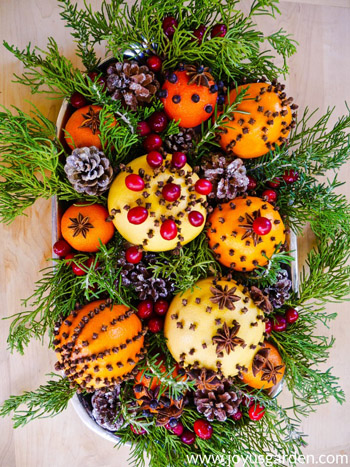
A box filled with festive fruit for Christmas
A basket of fruits sat next to the hearth according to French custom, and every Sicilian home set up a little altar (le cone) that held green leaves, oranges, lemons, pears, apples, figs, chestnuts and colored eggs. (7)
Decorations made with wheat were common in Northern, Central and Eastern Europe. During the long weeks of Advent, Slavic peoples wove strands of wheat into intricate designs; the most ancient was a sheaf of the finest grain hung upside down similar to the Polish połaźnik.
The Christmas Eve cross made by tying two bunches of wheat together was hung or placed on the table. Any extra straw was strewn on the floor, placed under the tablecloth and tied in bunches in the corners of the dining room. (8) In Scandinavian countries, bunches of grain were also placed outside on door posts and fences.
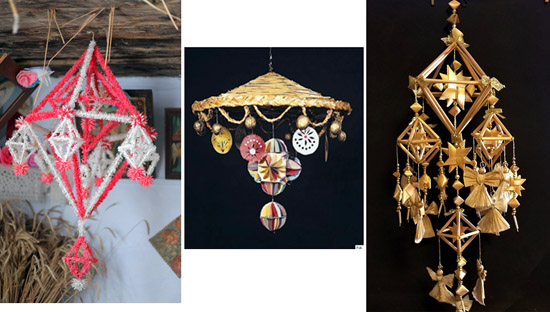
Slavic straw mobiles & ornaments
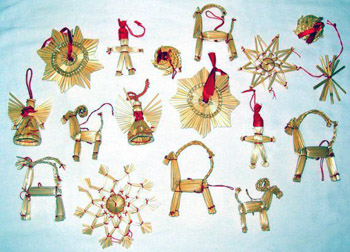
Scandinavian straw figurines
These Christmas decorations of greenery, flower and wheat were all proudly displayed throughout the Twelve Days of Christmas, and sometimes even longer. Then, on the Epiphany, or Candlemas, the house was carefully swept with every branch and leaf collected to be burnt, sprinkled on fields, planted with the garden crops or fed to the animals.
When sprinkled on the fields, the Christmas wheat would impart its blessings on the growing seeds.
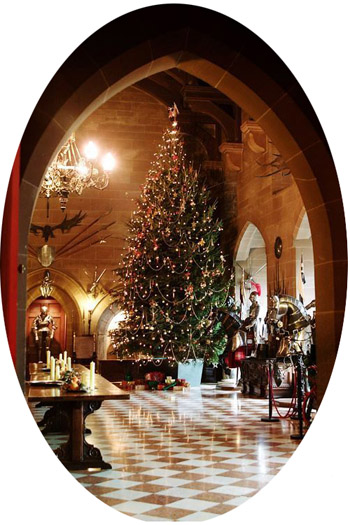
What a blessing it would be to see houses adorned on Christmas Eve with greenery, decorated trees, and artwork from the harvest, remaining on the walls and mantles all Twelve Days! In wealthier homes, the greenery would take on more splendor with delicate hand blown glass balls, ornaments of silver or gold and bells.
Then would Catholic hearts once again turn during this holy Season to the Eternal Word who deigned to descend from His Heavenly Throne to sacrifice Himself upon a Tree and feed us with His own Sacred Body.
To be continued
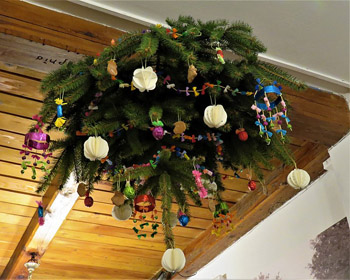
- Francis X. Weiser, The Christmas Book (New York: Harcourt, Brace and Company, 1952), p. 118.
- http://www.brauchtumsseiten.de/a-z/p/paradeisel/home.html
- Sophie Hodorowicz Knab, Polish Customs, Traditions, and Folklore (New York: Hippocrene Books, 1996), p. 31-32.
- https://www.arcanum.com/hu/online-kiadvanyok/MagyarNeprajz-magyar-neprajz-2/vii-nepszokas-nephit-nepi-vallasossag-A33C/szokasok-A355/jeles-napok-unnepi-szokasok-A596/december-A912/december-24-karacsony-vigiliaja-adam-eva-napja-A9B2/karacsonyfa-A9D3/
- Weiser, The Christmas Book, p. 119
- Maria Augusta Trapp, Around the Year with the Trapp Family (New York: Pantheon Books, 1955), pp. 52-56.
- Carol Field, Celebrating Italy (New York: William Morrow and Company, 1990), p. 255.
- Hodorowicz Knab, Polish Customs, Traditions, and Folklore, p. 31-33.
- Lee Wyndham, Holidays in Scandinavia (Champaign, Illinois: Garrard Publishing Company, 1975), p. 74.
- Weiser, The Christmas Book, pp. 127, 131.

Posted December 4, 2023
______________________
______________________
 |
 |
 |
 |
 |
 |


